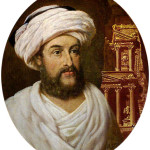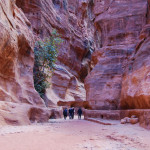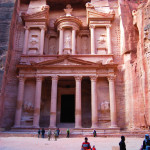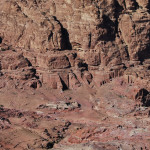Travelling in Jordan: Petra. History of Discovery. Part six
For almost seven hundred years Petra itself was absolutely forgotten by history and men, until a young Swiss traveller and scientist Johann Ludwig Burckhardt woke it up from its centuries-long sleep and discovered it for the modern science.
Johann Burckhardt was born in a family of a rich Swiss manufacturer in Lausanne on November 25 of 1784. Soon after that, the family moved to Basel, where it lodged in a luxurious palace called “Cherry Garden,” that was specially built for them. Little Johann received excellent education, but because of Napoleonic wars the father decided to send his son to the University of Leipzig, and then – to the University of Göttingen. But the victorious marching of Napoleon through Europe brings Johann on the insistence of his father to England, where his attention is brought to the British Association for Promoting the Discovery of the Interior Parts of Africa. Burckhardt, who dreamed from his childhood about journeys to the far away lands, found in it something that he was seeking for all his young years. It was a big blow for the parents to find out that their son would choose such a dangerous profession of a travelling explorer. It was one of Burckhardt’s cherished dreams to discover the famous Biblical Petra. This desire was even strengthened after he found several copper coins, on which the word “Petra” was inscribed in Greek. After carefully studying the Bible and ancient authorities concerning the probable location of Petra, and having explained to his Arab guides that he wanted to offer a goat on one of the peaks of Mount Hor, where according to the Biblical and other sources’ information Petra had to be, Burckhardt set out on his quest. In his diary, which we will mostly follow, Burckhardt noted his contemplations, “There is no other crossing of the roads like that between the Mediterranean and the Red seas, between Suez and Babylon, in this area. The ancient authors – Diodorus, Eratosthenes, and Strabo, gave quite a detailed description of Petra’s location. It is known that it is located in a mountanous region, in the midst of high rocks that are hard to reach. According to the description, this must be the place!”
Burckhardt purposefully did not disclose his true intention before the wild Bedouins, who suspected all Europeans, and not without a reason, of intending to steal the treasures of ancient kingdoms hidden in their lands. Because of this reason they did not let the Europeans to travel far into their lands, not to mention the ruins of the ancient cities. For many European travellers their curiosity cost them their lives. Burckhardt knew it too well, and he conducted himself with great care. So he and his guide were slowly approaching the majestic mountain range, rising over the neighbouring valley. Another traveller – Henry Morton, who approached these mountains one hundred years later wrote, “These were castellated fold mountains of dark-blue and purple colours, so barren and dead as if they were the borderline of an alien world – the mountains so ominous, that I was happy to hear the sound of horses stepping on the rocky ground. We rode for about forty five minutes, then made a sharp right turn and galloped directly toward the mountains. If someone had looked at us from a distance, he could have thought that we disappeared within the rock like ghosts, because the passage leading to Petra is a crevice in a huge rock, which is so narrow in some places, that when you stretch your hands you can touch both sides at the same time. The gorge that leads to Petra is called Al Siq. No city in the world is protected by such a tunnel; no city in the world has such an ominous passage leading to it.”
Let us imagine for a moment what Burckhardt could have felt as he went seemingly into nowhere along this narrow dismal gorge in the company of an armed Arab fanatic keeping a sharp eye on every move of his. This is what he wrote in his diary, “We went three hundred steps more. The gorge became a little wider, and on its edge there was a deep gulley that separated the path they walked from the steep slope of the rock. A little stream was flowing on the bottom of it. “When the stream spates in winter, it must flood the gulley, – decided Burckhardt, – and in summer the water is absorbed by sand and gravel.” But what is this? Along the banks of the stream, traces of stone facing can be noticed, and it seems that this canyon is designed to direct the flow of water. Of course, a little further it is cut in the rocks! It means that some people lived here, who tried to supply this arid mountainous land with water and at the same time to prevent the flooding, if the stream of water would be too powerful. Burckhardt admired the works of human hands who were able with such a skill to use the scarce natural landscape. In fifty more steps he saw a viaduct spanning the rocks. Above he caught a glimpse of some ruins, his eyes discerned big niches in the shadow of the gorge.
They followed the winding turns of Al Siq, and the number of niches was constantly growing. The niches were made separately or in groups of twos and threes; they were just mere hollows or they were framed on both sides with short pilasters. In some of the niches there were remains of pedestals for statues. The opening between the rocks widened. Burckhardt walked on, stumbling, not able to take his eyes off the unbelievable scenery which opened on both sides and up there, above him. Decortative molding, pylons, cornices, low doors – all of it was united into one to form some constructions. What kind of constructions were they? Maybe, tombs? Sanctuaries, altars? About ten feet high he saw four obelisks. They looked like the ones from Egypt. What period did they belong to? The gorge widened even more; the course of the stream joined another one, coming from the south direction. The darkness that filled the crevice was also dispelled. The bright light forced Burckhardt to shut his eyes for a moment, and when he opened his eyes again… right before him against the background of the rock, a temple was rising – huge, amazingly slender, as if glowing with pink-red colour of the sandstone, of which the temple was made, and, to top it all, its perfect preserved condition – everything was striking.”
Burckhardt could not take his eyes off this unusual spectacle, which this majestic temple (as he thought it was) presented, cut in a whole monolith rock. “Further there spread the valley spotted richly with the ruins of palaces, temples, piles of stones, broken pieces of columns… on mountainous terraces, made at different levels, houses and temples were caved directly in the rocks.” Stunned by the extraordinary scene of the city cut right in the rocks, Burckhardt forgot about his guide, who by that time looked at the European with undisguised anger, and eventually openly accused him of trying to steal the ancient treasures. Burckhardt’s attempts to reassure him that he was only interested in these beautiful buildings themselves, and, certainly, in offering the goat for sacrifice, not only did not calm down the Arab, but made him even angrier. Realizing all the danger of his situation, Johann decided to give up his passionate desire to continue the exploration of Petra, and after sacrificing a goat he was forced to leave this fabulous city, noting the exact whereabouts of it on the map. Later, he sent this information to Europe thus discovering this ancient capital of Edom for the scientific community and general public. This ancient capital, like other explorations of ancient civilizations by Burckhardt also, strengthened his faith into God even more. With his own eyes he saw the fulfilment of the Biblical prophesies and the vanity of human ambitions. And the dignified end of this still very young scientist tells of the peace that was given to him by God. “Before his death more and more often he goes back in his thoughts to his native Switzerland. The newspapers say that there is famine and need there. Switzerland buys grain from the French and Italians at tripled prices, and they import it from Egypt. In Alexandria’s port he saw in person two hundred and fifty European ships loaded with wheat, barley, beans, peas, and proso millet. Mohammed Ali just in five months of that year sold to Europe one and a half million quintals of all kinds of grains.
On August 20, 1817, Burckhardt sends a cheque to Switzerland for a large sum and asks his mother to give the money to the poor. “This is so negligibly little, – he says at the same time, – that I cannot even boast of doing a good work, but still, if this little amount turns into clothes, it will help many families to survive the coming winter better.” “You think that I have changed a lot, – writes Burckhardt to his mother, – It is only that my skin has become darker, I have wrinkles, and my beard grew longer. But I hope that when I shave my beard and take off my Turkish array, I will still look quite presentably.” “I am not troubled, I know that I am fulfilling my duty, and I am joyfully looking into the future. I am ready for both good and bad, no matter what it may bring me, but whatever the case, I hope to attain one goal – to see you in this life or in the next one. Believe me, my dear mother, my desire to see you is many times greater than the desire for fame, honour or recognition, and your praise is much more precious than that of the crowd. Fame, if it ever comes, is an empty feeling, but devoted love for your mother and being faithful to your duty in the most difficult situations of life – this is the feeling that uplifts the soul.” He dies on October 17, 1817. He was only thirty three years old, and in his lifetime nothing of what had been written by him was published. Only in 1819, at the cooperation of the African Association his vast works started to be published in English – Travels in Nubia, Travels in Arabia, Travels in Syria and the Holy Land, Notes on the Bedouins and Wahabys, Arabic Proverbs, or the Manners and Customs of the Modern Egyptians. Almost at the same time all these books were translated into German language and published in Germany. “Few travellers, – German Review wrote about him, – had such a keen power of observation – this natural gift, which, like any other talent, is quite rare to find. He had a special hunch that helped him to discern the truth even in those cases when he could not act on his personal observations… His investigative mind, which was mature beyond his age because of constant contemplations and scientific studies, aims directly for the goal and stops at the needed point. His stories are always sober and full of facts; nevertheless, you read them with immense enjoyment. In these stories he makes you love him as a man, as a scientist, and as an excellent observer.” Soon after Burckhardt’s death, archaelogical expeditions streamed to Petra and the territory of the former kingdom of Edom, to uncover the numerous mysteries of these ancient places. These lands wree explored by the expeditions of R. Dussoe and F. Macler, R. E. Brjunnov and A. Domashevsky, A. Muzil, A. Zhossen and R. Sauvignac, G. Dalman, N. Gluck, J. Starki.
Petra, however, fascinated scientists, including those who were far from religion, not only by the mysteries in its history to be solved, but also by the fact that Biblical prophesies were fully fulfilled in its history. One of the archaeologists left the following note in his diary, “”I wish an unbeliever would be in my place, among the ruins of the city in the rocks, to open the Holy Book and read the words of the inspired prophet, written back at that time when this forlorn corner of the earth was one of the greatest cities of the world. I imagine how stunned would be this former mocker, how his cheeks would become pale, his lips would tremble, and his heart would start beating fast out of fright, while this destroyed city cries in its mighty and powerful voice, as if having been raised from the dead. And may he not believe Moses and the prophets, but it is impossible not to believe the handwriting of the Lord Himself, inscribed on these desolated eternal ruins.” It seemed that because of its geographical and political position Edom would exist forever, but it rejected God and replaced the worship of God with dreadful human sacrifices. So God on the pages of the Bible through prophet Malachi justly said, “Edom may say, “Though we have been crushed, we will rebuild the ruins.” But this is what the Lord Almighty says: “They may build, but I will demolish. They will be called the WickedLand, a people always under the wrath of the Lord. You will see it with your own eyes and say, ‘Great is the Lord—even beyond the borders of Israel!” (Malachi 1:4-5). So in our days the descendants of Jacob are still living, and, according to the prediction of the prophesy, they possess one part of Edom’s lands, while the tribes from the south – that is, the Arabs, possessed the other part. The dreadful bloody steps toward the Sun, by ascending which Edom worshipped its gods, brought it to the fall. The road that it thought to be the path to heaven and to prosperity became for Edom the road into the abyss.
This material is taken from the article by professor A. A. Oparin (Ukraine) Ancient Petra: Tombs. Altars. Sacrifices., published in magazine Review of the World Issues on April 3, 2013.




